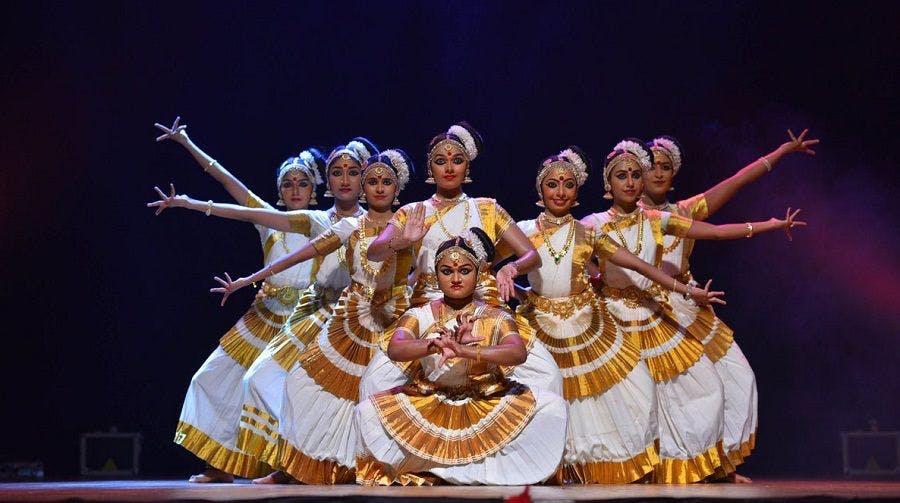Even though the 16th-Century literature Vyavaharamala mentioned Mohiniyattam, it was Kunchan Nambiar in the 18th Century who first described the costumes and movements of the art form.
Kalakkathu Kunchan Nambiar was a renowned poet of Kerala in the 18th century and is credited with the revival of OttanThullal. Kunchan Nambiar, together with Ezhuthachan, is credited as the earliest literary figure who used pure Malayalam in his literary works leading to the evolution of Malayalam literature independent of Sanskrit and Manipravalam. He was also an expert performer of the Mizhavu drum that accompanies Nangiarkoothu and Koodiyattam.
Thus he was well-versed in the rhythm, music and acting techniques used in Kerala art forms. The earliest references to Mohiniyattam as a dance form of Kerala is found in the poems of Kunchan Nambiar. While the references in Vyavaharamala indicates the existence of a dance form in the name Mohiniyattam in the Kerala region, Kunchan Nambiar’s poems also allude to the character, costumes, music and movements of the dance form as it existed in the 18th Century.
The musicality of the dance performances is described in detail in some works mentioning the melodies (raga) and rhythms (tala) used by the dancers and musicians. The context, a premise of dance including in the processions organised in temples are also described. From all this contextual information, we can glean a detailed account of the female dance form.
Mohiniyattam in ‘Thullal’ Poems
In the 18th Century, Kunchan Nambiar wrote Tuḷḷal poems based on mythological, stories. Though the stories were mythological, he held up a mirror to the actual social situations of life in Kerala during that period to elaborate on his themes. Many of the descriptions about the dancers are identical to the style and techniques of Mohiniyaṭṭam dancers. Here are a few lines:
“Naṭakanaṭanam narmmavinodam
Paṭhakapaṭhanam pavakkuttum
Maṭaṇimulamar mohiniyaṭṭam
Paṭavamerina pala pala melam” (From Ghoṣayatra)
Mohiniyaṭṭam is included in the group of art forms that requires skill, intelligence and efficiency and this point out the range and potentiality of the dance.
“Cheppatividya Kurattiyattam pala
Cheppayaticchupolikkum kaliyum
Alppanmarkku resippan nalla
Cheruppakkarude mohiniyattam’
(From Chandramgada Charitam)
Wizardry (cheppaṭividya) and Kurattiyaṭṭam, explained in the above lines, are more excessive art forms that have their bearings on the regional and folk traditions and practise no sound control. Mohiniyaṭṭam dancers were described mostly as young women and the dance was considered to be entertainment for young men of little worth. As a matter of fact, Mohiniyaṭṭam suffered small damages and was looked down upon by society at the time.
“Varnnangalum chilapatikkalikkanam
Varnnannalonnalla rantalla munnalla-
Nirnnayam ninnalkku ventuvolam vasam
Vinnavarnattile pennunnalenniya-
lennamillennu janangal parayunnu”
The first ever guru of Mohiniyattam at Kerala Kalamandalam, Orikkaledathu Kalyaniyamma, used to sing to and perform Mohiniyattam. Her guru, Krishna Paniker Ashan, would perform the Nattuvangam and Madhava Warrier would accompany on Maddalam when she danced. The accompanists would stand behind the performer and provide the music support. This arrangement was revised by Vallathol later in Kalamandalam.
The Varnam was an established item in the repertoire of Mohiniyattam from the olden days. Kunchan Nambiar also mentioned the innumerable wives of devas. While this need not necessarily be a reference to the devadasi tradition, it does point to the fact that dancing styles that considered the female dancers as the consorts of celestial beings were not unheard of in the region of Kerala.
(Assisted by Sreekanth Janardhanan)
Click here to read the other article in the series

